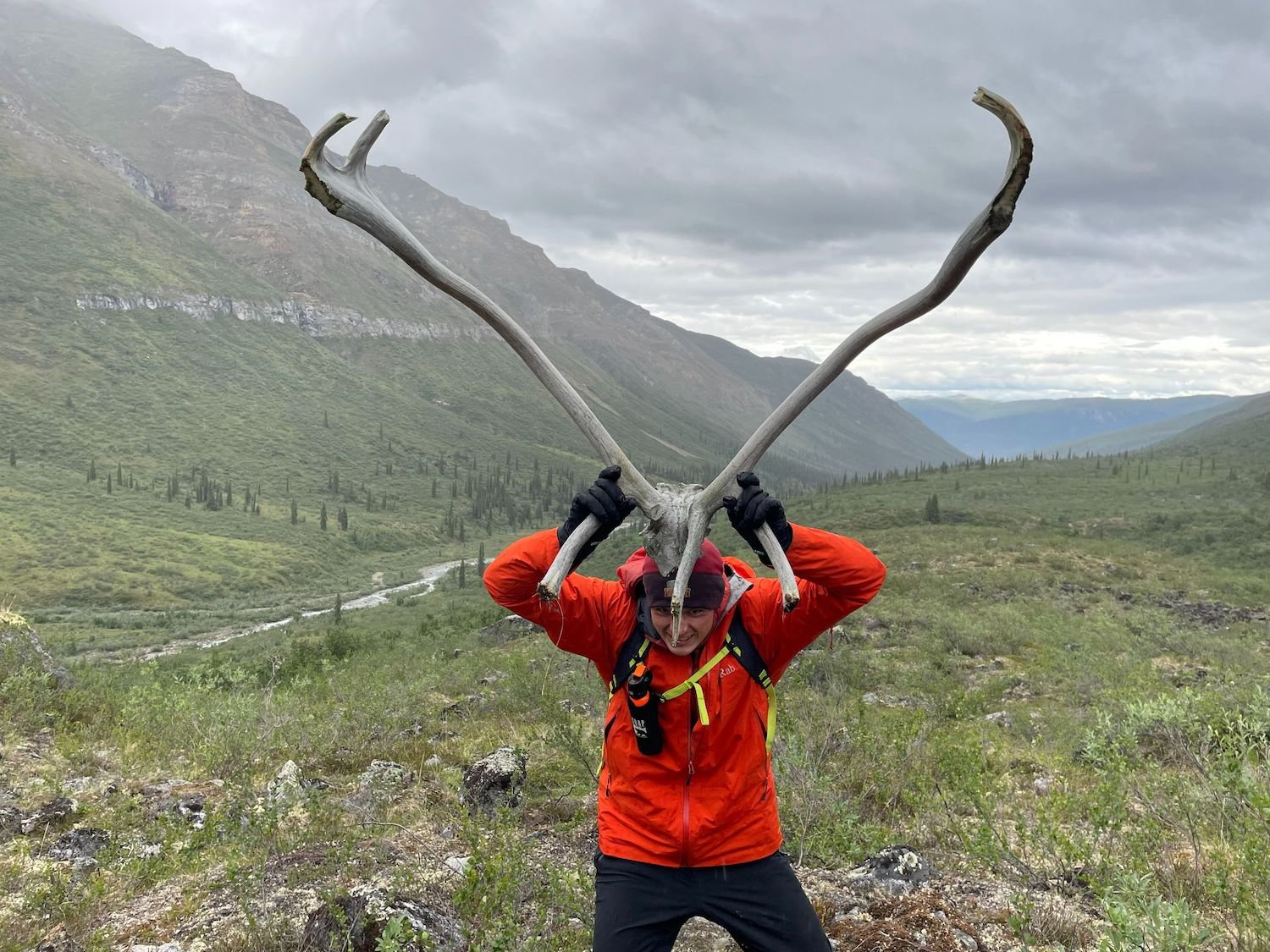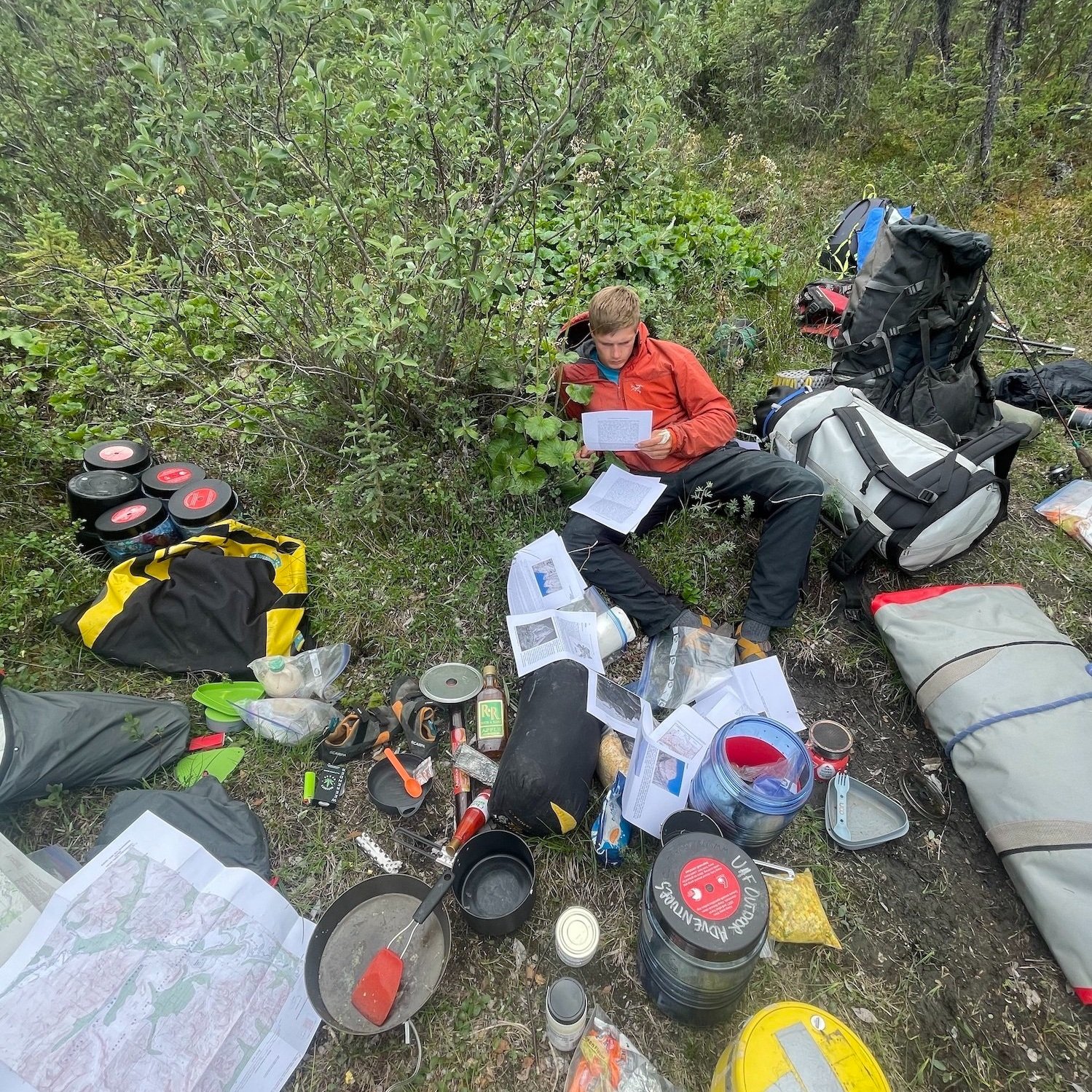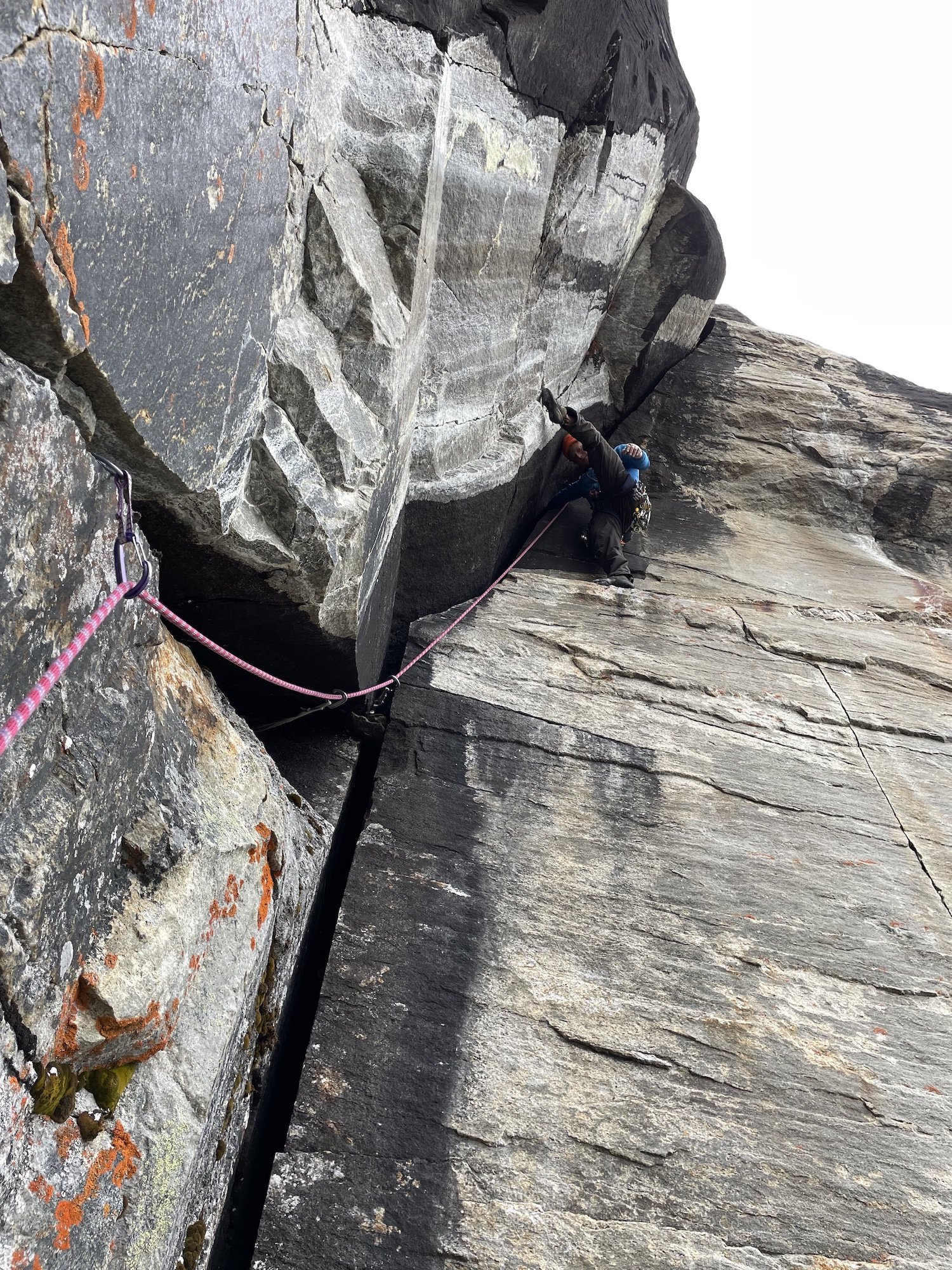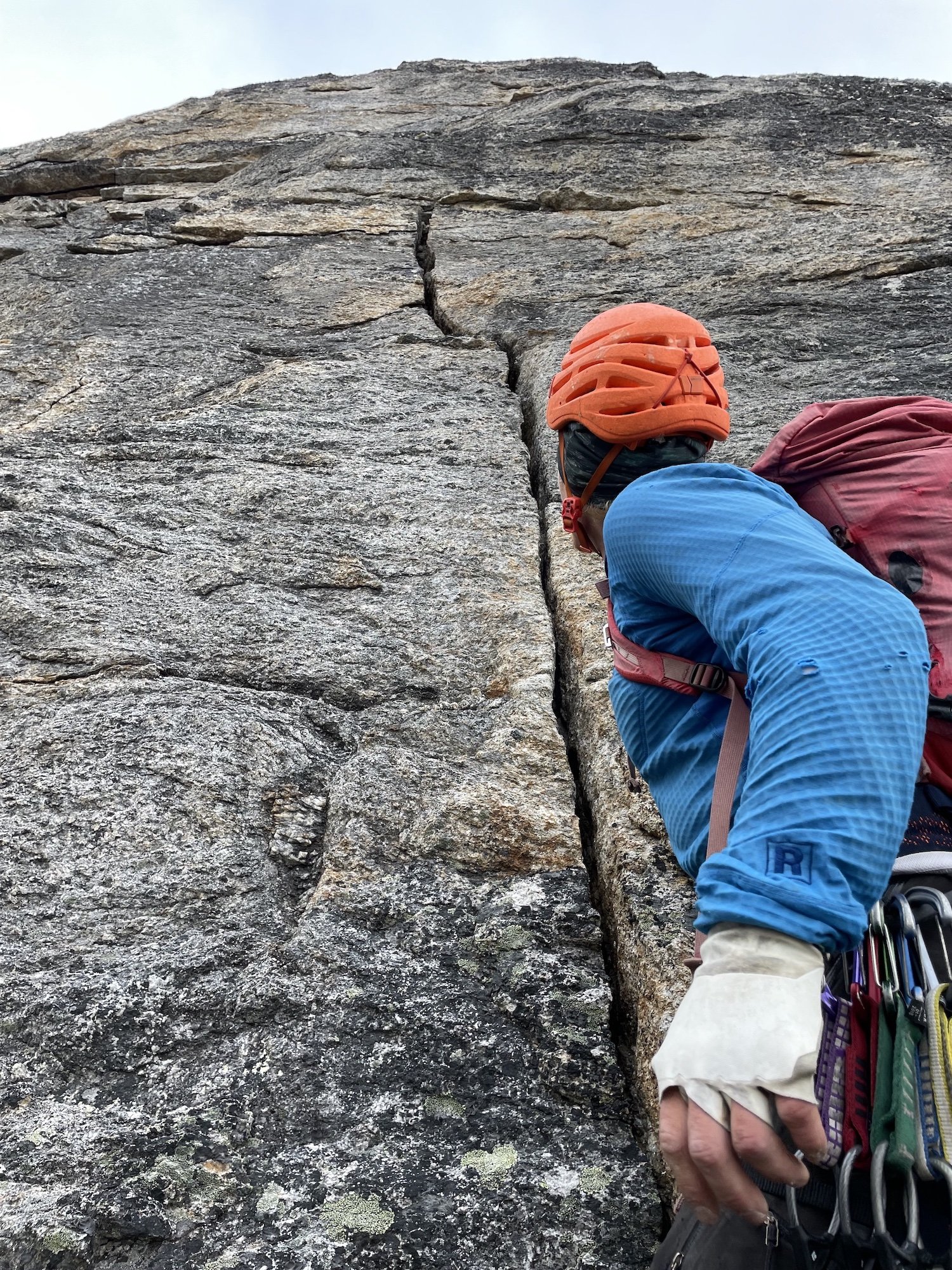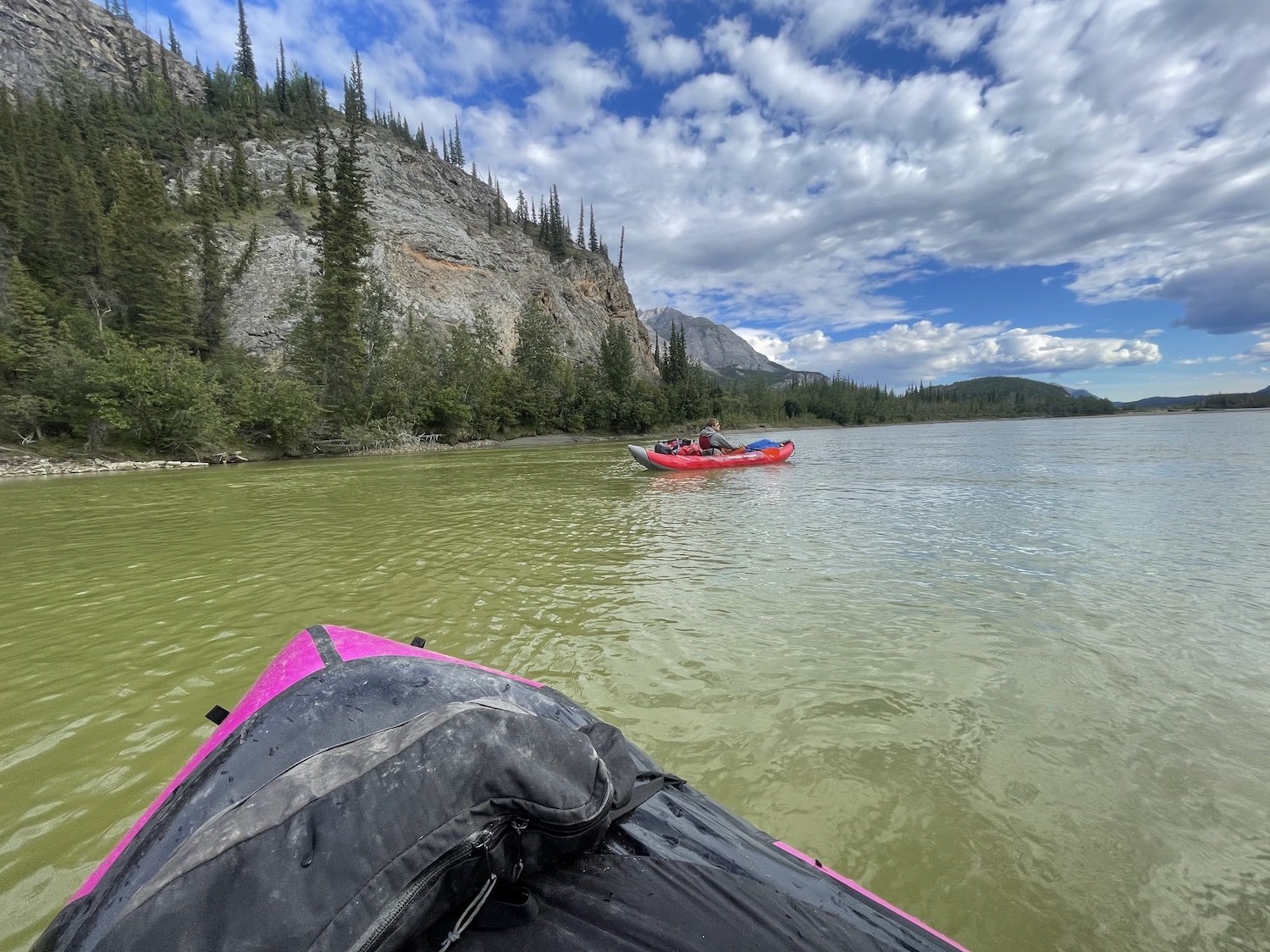The Emperor Face of Mt. Robson in water color and ink. AAC member Craig Muderlak
Mountain Sense
By Sierra McGivney
Usually, when Balin Miller encounters spindrift ice climbing, he puts his head down, waits for 10 to 20 seconds, and continues climbing. Halfway up the face of the Andromeda Strain, a line on the northeast face of Mount Andromeda in Alberta, Canada, Miller and his climbing partner Adrien Costa encountered an intense spindrift funnel. Thirty seconds passed, then one minute, two. After five minutes, he thought, f*** this, and downclimbed.
Miller was persistent, but the spindrift was relentless. They wasted a couple of hours trying to go around.
“You couldn’t see anything, even if you wanted to push through,” said Miller.
Miller and Costa peered around to where the climbing turned into a chimney. A wall of white snow poured down it. They turned back a pitch before the Hockey Stick Crack, disappointed that they wouldn’t be able to live the lore embedded in that pitch. This wouldn’t be the last time they tested their judgment in the mountains and turned away from an objective.
“I think what gets me most stoked for routes isn’t really how good they are, per se, but a lot of the history involved in it—the route that has some old trip report of people getting really scared on it,” said Miller.
This might be why Miller chose the Andromeda Strain as one of his objectives for this 2023 Mountaineering Fellowship Fund Grant (MFFG) trip. Apart from being one of the most popular yet serious alpine climbs in the Canadian Rockies, it has an epic story. An unsuccessful earlier group tried to ascend the off-width and found it too wide to take anything but one-foot lengths of hewn-off hockey sticks (an eerie, early rendition of the Trango Big Bro). Having no hockey sticks handy in 1983, Barry Blanchard, Dave Cheesmond, and Tim Friesen traversed beneath the off-width and around the corner to a steep snow-choked chimney that became the Hockey Stick Crack.
Miller originally applied for the MFFG from the American Alpine Club to support an expedition to the Alaska Range. He was awarded the grant but had to change his trip to the Canadian Rockies due to financial constraints. This grant funds climbers 25 years or younger seeking challenging climbs in remote places. One of Miller’s partners, Adrien Costa, has previously leveraged other AAC grants, including the Tincup Partner in Adventure Grant in 2021 and the Catalyst Grant in 2021 and 2023. The AAC grants can be a great jumping-off point for climbers looking to dream big.
Miller is an ice climber who spends his summers in Alaska and his winters in Bozeman. He got into climbing at the age of 12 and was versed in both ice and rock climbing growing up in Alaska. He is stalwart when it comes to ice climbing, but he has a goofy aura. You can deduce from photos of his trip that he doesn’t take himself too seriously, even on big alpine climbs.
After getting turned around on the Andromeda Strain, Miller and Costa climbed Dreambed (5.11 PG-13) on Mount Yamnuska and enjoyed a sunny day on rock. The two saw a weather window coming up and turned their gaze to Mount Robson or Yuh-hai- haskun (“The Mountain of the Spiral Road”), the highest peak in Canada. Infinite Patience (2200m, VI 5.9 WI5 M5) climbs the north side of the Emperor Face of Mount Robson until it merges with the Emperor Ridge (2500m, V 5.6). This was another big objective for Miller. Despite a solid weather window and the season being in their favor, new challenges awaited the group.
Aidan Whitelaw, six feet, four inches tall with a high-pitched voice, is one of Miller’s best friends. Despite being a student at Montana State University in Bozeman, he’s almost always down to skip class if it means going climbing.
With Whitelaw newly arrived, they set off on their adventure with only one rope, trying to go as light as possible. One rope between three climbers is OK if they don’t need to bail, but just in case, the team brought a Beal Escaper.
Miller wrote in his trip report: “Leaving the parking lot on October 5, Aidan Whitelaw, Adrien, and I hiked into Berg Lake, camping at the base of the face. [We] started up the face at 2 a.m. on the 6th. We soon realized that the direct start was out of condition. It’s usually [three pitches of WI 4 or 5] but turned out to be steep, wet melting snice. We opted to traverse right to gain Bubba’s Couloir. Unfortunately, there was no alpine ice left in the couloir. But the snow climbing was moderate but unprotectable. We eventually decided to bail after the House Traverse, which is roughly halfway up the Emperor Face to the ridge on Infinite Patience.”
Deciding to bail had become extremely obvious to the group. They encountered compact limestone with no cracks and nothing to sling. The group was fine leaving cams or pins but couldn’t find good placements to make anchors. They decided to deadman their ice tools, burying them to create a snow anchor to rappel off.
“It was the worst rock imaginable,” said Miller.
Eventually, they reached a bivy spot and got cozy, fitting three people into a two-person tent and Whitelaw and Miller into one sleeping bag. At noon the next day, they started their descent, which consisted of rappelling off V-threads and lousy rock anchors.
Balin Miller, Adrien Costa, and Aiden Whitelaw at the bivy spot on Infinite Patience getting cozy in a two-person tent. Land of the Mountain Metis, Stoney, Cree and Secwepemc peoples. AAC member Balin Miller
The Beal Escaper is a detachable rappelling device that allows you to descend on a single strand without permanently fixing the rappel and sacrificing the rope. To retrieve the rope, the climber tugs the rope ten to twenty times, causing the rope to inch through the Escaper and retrieve the rope.
The group was on 80-degree melting snow. No one had counted how many times they had pulled the rope to disengage the Escaper, but something was wrong. Everyone got quiet. They pulled as much rope through as they could, but ultimately, the rope refused to release. Unable to jug back up the rope out of fear that movement could release the device, and unable to solo back up because of 80 feet of steep bad snow and friable rock, they pulled out as much rope as they could and cut it. Only eight meters of rope were in their hands, the rest of it lost to the mountain. It was dark, and they didn’t know how far they were above the Mist Glacier.
They tied slings together as a pull cord, allowing them to do increments of full eight-meter rappels. Luckily, they were only 100 feet from the bottom.
Twenty-four hours later, Whitelaw was in class in Bozeman, Montana; no one was aware of the epic in the mountains he had just returned from.
Balin Miller questing off to lead a mixed pitch on Infinite Patience (VI5.9M5WI5).Land of the Mountain Metis, Stoney, Cree, and Secwepemc peoples. AAC member Adrian Costa
After several days off, Miller and Costa hiked into the Lloyd McKay Hut to attempt the north face of Alberta. However, they didn’t get the chance due to a storm and nine inches of wet snow. Miller wasn’t too bummed. Conditions weren’t in their favor, and there was always next year. Both Miller and Costa left after that, and Miller headed to Yosemite.
In November, Miller returned ready to ice climb. He climbed Suffer Machine (200m, WI5+ M7); Virtual Reality (100m, WI6+); Kittyhawk (150m, WI5), solo; and Nemesis (150m, WI6), solo.
He took a short break to visit his mom in Spokane, Washington. Ethan Berkeland flew out to meet him, and the pair drove about 430 miles back up to Canada with Slipstream in sight. Slipstream (900m, IV WI4+) climbs the east face of Snow Dome. It is infamous for it’s exposure to dangerous seracs, avalanches, and cornices, as evidenced by five reports in the Accidents in North American Climbing archive. Jim Elzinga and John Lauchlan first climbed it in 1979, and Mark Twight simul-soloed it in 1988 with Randy Rackliff.
“Anything Mark Twight does is awesome,” said Miller.
The previous fall, Miller had bailed after the approach when it had taken longer than expected, and “it just didn’t feel right.” Both Miller and Berkeland are solid ice climbers. They brought a full rope, a tagline, 14 screws, and a handful of draws, planning to solo the easier parts and pitch out the harder ones. They ended up simul-soloing the entire east face of Snow Dome on November 29 in four hours. In total, the day was thirteen hours from car to car.
After getting turned around on his previous alpine objectives, this was a great achievement for Miller.
Despite the epics on some of his original objectives, Miller found success. Each “failure” in the mountains is a lesson learned for the next climb, maybe even a cutting-edge ascent. The spindrift turned him around on Andromeda Strain, and Infinite Patience was out of condition, but Slipstream proved to be an amazing climb. Sometimes, infinite patience pays off in the mountains.
Support This Work— Join or Give Today
Your contribution will significantly impact climbers—whether they are learning how to avoid accidents through our updated database, using research funding to analyze melting ice caps and the changing heights of iconic mountains, or pursuing first ascents around the world. Your gift makes these things possible.






